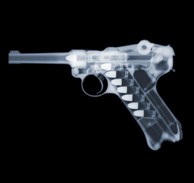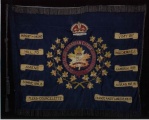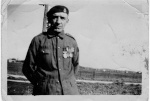I have a 1937 pattern web belt with oid oil stains. (found it in a barn) I'm thinkin a soak in TSP the into the wasshing machin in a bag so the brass doesn't hammer around.
5 posters
Cleaning real dirty webbing

Infanteer- Member
- Posts : 820
Join date : 2009-12-11
- Post n°2
 Re: Cleaning real dirty webbing
Re: Cleaning real dirty webbing
I would love to see before and after photos if it's not too late. If necessary, I normally only wash items in Woolite without scrubbing and then wrap in a towel to remove as much water as possible followed by air drying out of direct sun light. I have used a stain remover gel with some success but in my experience too much cleaning usually results in less then desirable effects (spotty effect due to fading of the webbing). Not sure how well original maker marks will withstand heavy cleaning. My advice would be to not get too aggressive with your cleaning unless you are going to treat it with blanco afterwards. One time, I was able to use a strong solvent to remove some heavy 50's era blanco from a belt but there were no markings to begin with and the solvent evaporated quickly and didn't cause fading or shrinkage.

George G- Member
- Posts : 72
Join date : 2011-10-26
- Post n°3
 Re: Cleaning real dirty webbing
Re: Cleaning real dirty webbing
I haven't done anything yet. I havn't been able to find any markings on the webbing. What is Blanco/

Battalion Colours- Moderator
- Posts : 846
Join date : 2009-11-26
- Post n°4
 Re: Cleaning real dirty webbing
Re: Cleaning real dirty webbing
http://en.wikipedia.org/wiki/Blanco_(compound)
Blanco was a compound used by British soldiers (and Commonwealth troops of various nations). The compound was used from 1880 to whiten British Army Slade Wallace buckskin leather equipment then adapted to coloured versions for use on the cotton Web Infantry Equipment, Pattern 1908 webbing used in World War I and beyond and the Web Equipment '37 Pattern during the Second World War, though rarely outside of the United Kingdom and Europe[citation needed]. Blanco was used throughout both World wars, into the period of National Service and into the 1980s by cadets and the Territorial Army.
Blanco initially came in either powder manufactured by the Mills Equipment Company (who designed and were a primary manufacturer of the webbing it was used on), or round cake form, much like soap, manufactured by Pickerings and which used the tradename "Blanco" and was used as a cleaning and colouring compound. Blanco was applied with a brush and water, and rubbed into the woven cotton material of load bearing equipment, to provide a consistent colour to equipment worn by soldiers in the same unit, and as a method of cleaning the gear. Post WWII experimental rectangular waxy blocks became available with greater waterproofing abilities but after 1954 Joseph Pickering & Sons Ltd introduced a tinned paste product that didn't need the addition of water and could be applied directly from the tin. Other manufacturers made competing tinned paste products until the 1980s.
Blanco came in many different colours, the most common being shades of "khaki" (in practice, a tan colour) or olive green, though white was also used. Black if used was achieved by using boot polish. There were several shades of green used, which are not easy to distinguish in black and white period photos, with shade 97 (light green), and shade KG3 (dark green) being most common. Additionally there was "RAF Blue" for RAF blue grey web equipment. As an alternative khaki coloured mud was used at times to produce tan coloured equipment. Scrubbing the webbing in Sea Water produced a near white result. A post-WWII blanco colour adopted by at least one unit of the Parachute Regiment (5th - later renumbered 15th Scottish Battalion) was maroon, using the waxy form of blanco to give a shiny scuff-resistant finish.
The word also became used as a verb, as in "to blanco a piece of equipment". The past tense of blanco is usually seen in print as "blancoed".
It appears in the phrase "Bull, Blanco and Brasso" to refer to the methods used to bring uniform to immaculate condition.
Blanco was a compound used by British soldiers (and Commonwealth troops of various nations). The compound was used from 1880 to whiten British Army Slade Wallace buckskin leather equipment then adapted to coloured versions for use on the cotton Web Infantry Equipment, Pattern 1908 webbing used in World War I and beyond and the Web Equipment '37 Pattern during the Second World War, though rarely outside of the United Kingdom and Europe[citation needed]. Blanco was used throughout both World wars, into the period of National Service and into the 1980s by cadets and the Territorial Army.
Blanco initially came in either powder manufactured by the Mills Equipment Company (who designed and were a primary manufacturer of the webbing it was used on), or round cake form, much like soap, manufactured by Pickerings and which used the tradename "Blanco" and was used as a cleaning and colouring compound. Blanco was applied with a brush and water, and rubbed into the woven cotton material of load bearing equipment, to provide a consistent colour to equipment worn by soldiers in the same unit, and as a method of cleaning the gear. Post WWII experimental rectangular waxy blocks became available with greater waterproofing abilities but after 1954 Joseph Pickering & Sons Ltd introduced a tinned paste product that didn't need the addition of water and could be applied directly from the tin. Other manufacturers made competing tinned paste products until the 1980s.
Blanco came in many different colours, the most common being shades of "khaki" (in practice, a tan colour) or olive green, though white was also used. Black if used was achieved by using boot polish. There were several shades of green used, which are not easy to distinguish in black and white period photos, with shade 97 (light green), and shade KG3 (dark green) being most common. Additionally there was "RAF Blue" for RAF blue grey web equipment. As an alternative khaki coloured mud was used at times to produce tan coloured equipment. Scrubbing the webbing in Sea Water produced a near white result. A post-WWII blanco colour adopted by at least one unit of the Parachute Regiment (5th - later renumbered 15th Scottish Battalion) was maroon, using the waxy form of blanco to give a shiny scuff-resistant finish.
The word also became used as a verb, as in "to blanco a piece of equipment". The past tense of blanco is usually seen in print as "blancoed".
It appears in the phrase "Bull, Blanco and Brasso" to refer to the methods used to bring uniform to immaculate condition.
_________________
Adam
"Honneur et Fidélité"



jholl72- Administrator
- Posts : 949
Join date : 2009-11-24
Age : 52
Location : Ontario, Canada
- Post n°5
 Re: Cleaning real dirty webbing
Re: Cleaning real dirty webbing
Do NOT use the washing machine!!! I know a guy who did this and all the webbing fell apart!
_________________
Regards,
Jeff

pylon1357- Global Moderator
- Posts : 1351
Join date : 2009-11-24
Location : Resting on my laurels in Ottawa
- Post n°6
 Re: Cleaning real dirty webbing
Re: Cleaning real dirty webbing
jholl72 wrote:Do NOT use the washing machine!!! I know a guy who did this and all the webbing fell apart!
Was the guys name Jeff by chance??

_________________
Cliff
http://www.irishregimentofcanada.ca

Infanteer- Member
- Posts : 820
Join date : 2009-12-11
- Post n°7
 Re: Cleaning real dirty webbing
Re: Cleaning real dirty webbing
pylon1357 wrote:jholl72 wrote:Do NOT use the washing machine!!! I know a guy who did this and all the webbing fell apart!
Was the guys name Jeff by chance??
Cliff, I finally got my UAB! I have something for you....

George G- Member
- Posts : 72
Join date : 2011-10-26
- Post n°8
 Re: Cleaning real dirty webbing
Re: Cleaning real dirty webbing
George G wrote:I have a 1937 pattern web belt with oid oil stains. (found it in a barn) I'm thinkin a soak in TSP the into the wasshing machin in a bag so the brass doesn't hammer around.
I did it.
I soaked the stuff if water and TSP overnight. Then into the washing machine on warm for a long cycle. Then air dried.
No damage and it came out clean. Even the brass is less tarnished. Looks like the webbing belt is RCFA blueish in color.
Not sure how to post teh before and after photos.
|
|
|

